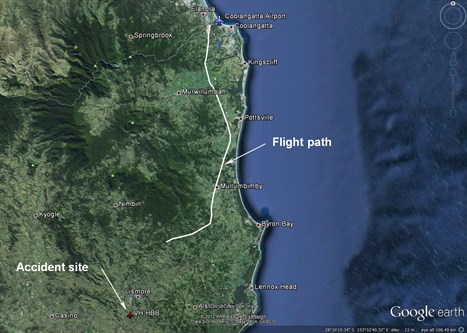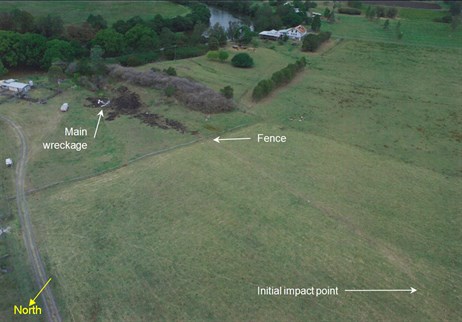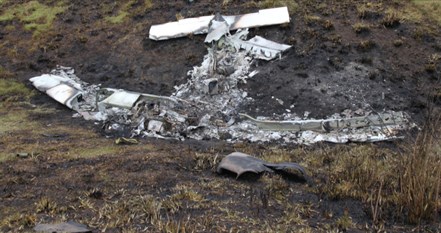Update 18 December 2012
At about 0825 Eastern Standard Time1 on 9 November 2012, a student pilot and instructor departed Gold Coast/Coolangatta Airport, Queensland, for a training flight in VH-HBB, a SOCATA TB‑20 Trinidad. The student pilot had passed the general flying progress test (GFPT)2, but the student had recently acquired the Trinidad aircraft and was under the supervision of an instructor to undergo conversion training for the new aircraft.
The student had primarily carried out their previous flight training on Cessna 172 aircraft (172) that had fixed landing gear and a fixed pitch propeller. The Trinidad differed from the 172 in a number of ways that included having retractable landing gear and a variable pitch, constant speed propeller. Those features were considered to be ‘special design features’ and the conversion training being undertaken included endorsements for those special design features. The flight on 9 November was the student pilot’s sixth and the instructor’s seventh flight in the aircraft, having accumulated 7.8 hours and 8.9 hours, respectively, during the previous flights.
On the day, the aircraft departed from Coolangatta to the north before turning south. The aircraft was initially being tracked by the air traffic control radar, but at about 60 km south-south-west of Coolangatta the aircraft flew outside radar coverage (Figure 1).
Figure 1: Flight path of VH-HBB

Source: Google Earth
The path taken by the aircraft following the loss of radar coverage was unknown. However, at about 0845, the pilot broadcast on the Lismore common traffic advisory frequency (CTAF) that they were about 8 NM (15 km) north of Lismore Airport, New South Wales (NSW) and inbound to conduct circuits3 on runway 33 at Lismore. Reports indicated that the aircraft had completed a number of circuits prior to the accident.
At about 09154, a number of witnesses travelling along the Bruxner Highway between Lismore and Casino, NSW observed the aircraft make an abrupt steep left bank before pitching nose down and rapidly descending. The aircraft’s nose was then observed to have been raised and its rate of descent reduced before crossing the Bruxner Highway at very low height. The aircraft impacted the ground in a paddock adjacent to the highway. Both occupants on board the aircraft were fatally injured.
The Australian Transport Safety Bureau (ATSB) initiated an investigation and attended the accident site. The ground impact marks observed by the ATSB indicated that the aircraft impacted the ground in a left wing-low attitude with the nose of the aircraft level, or slightly nose-up. The left main and nose landing gear separated from the aircraft and it continued to skid along the ground. The aircraft continued through a wire fence, where the fuel escaped from the tanks and caught alight, before the right wing impacted the ground and the aircraft flipped over, coming to rest inverted about 170 m after the initial impact point (Figure 2). The engine separated from the fuselage during the impact sequence and came to rest about 13 m beyond the main aircraft wreckage.
Figure 2: Accident site

Source: NSW Police
An intense fuel-fed fire continued to burn around the aircraft following the accident. That fire destroyed a substantial amount of the aircraft structure (Figure 3).
The investigation is continuing and will include:
- examination of the engine and propeller
- examination of the experience of the student and instructor
- assessment of the aircraft’s handling qualities.
The evidence will be analysed and a final report completed detailing the findings of the investigation.
Figure 3: Main wreckage

Source: ATSB
______________
[1] Eastern Standard Time was Coordinated Universal Time + 10 hours.
[2] A GFPT indicates that a pilot has attained a standard in the safe control and handling of an aircraft. The test does not assess flight navigation beyond an ability to fly in the vicinity of the departure aerodrome and the approved training area. The pilot remains a student pilot until a private or a commercial flight test has been passed.
[3] A standard rectangular traffic pattern flown around an aerodrome when taking off from, or landing on a runway.
[4] The local time at Lismore was 1015 Eastern Daylight-saving Time (UTC+11).
The information contained in this web update is released in accordance with section 25 of the Transport Safety Investigation Act 2003 and is derived from initial investigation of the occurrence. Readers are cautioned that new evidence will become available as the investigation progresses that will enhance the ATSB’s understanding of the occurrence as outlined in the web update. As such, no analysis or findings are included in this update.
Update 12 November
ATSB investigators began the on-site phase of the investigation on Saturday 10 November.
The team has been liaising with the local police to secure perishable evidence, including the pattern of the wreckage and marks from impact.
The ATSB has retained the aircraft’s engine for later technical examination.
Over the next few days, the team will be:
- interviewing witnesses
- meeting with the aircraft operator
- retrieving aircraft and pilot records.
The on-site wreckage examination will be completed later today and the ATSB aims to finalise the investigation by November 2013.
This page will be updated as significant information comes to hand.
Subscribe now to receive news and information from the ATSB and follow us on twitter @atsbinfo for investigation updates.
9 November 2012
The ATSB is investigating an accident involving a SOCATA TB-20 that collided with terrain at Lismore on 9 November 2012.
The aircraft was seen to bank left and impact the ground. It was destroyed by fire and the two people on board died as a result of the accident.
The ATSB has sent a team of investigators to begin the on-site phase of the investigation.
Investigators will be:
- examining the wreckage for evidence
- interviewing witnesses and aircraft operator
- reviewing maintenance documents.
The ATSB will also review the pilot’s training and experience and collate and analyse witness information.
If you have any information about the accident please call the ATSB on 1800 020 616.





